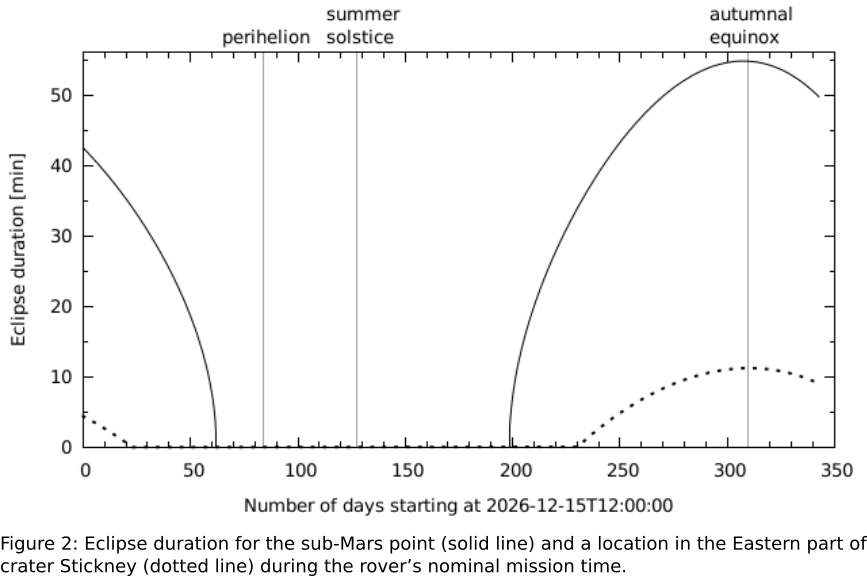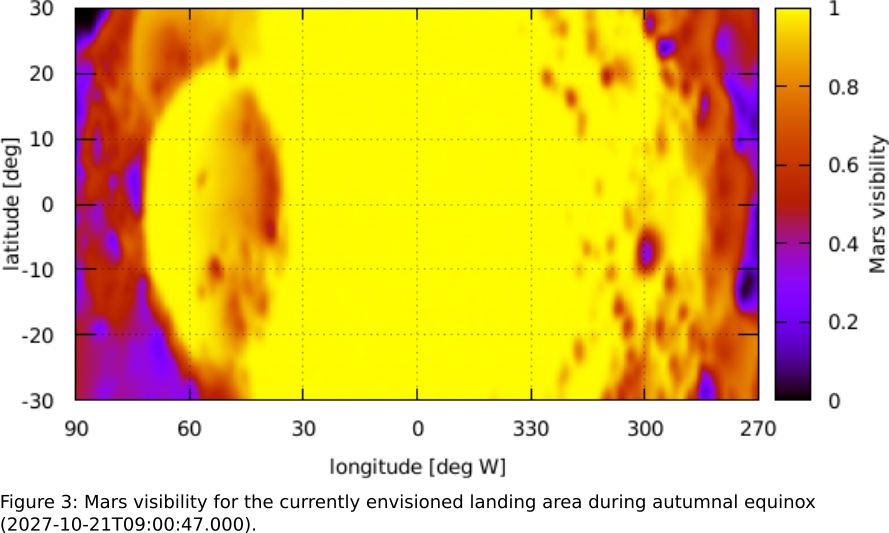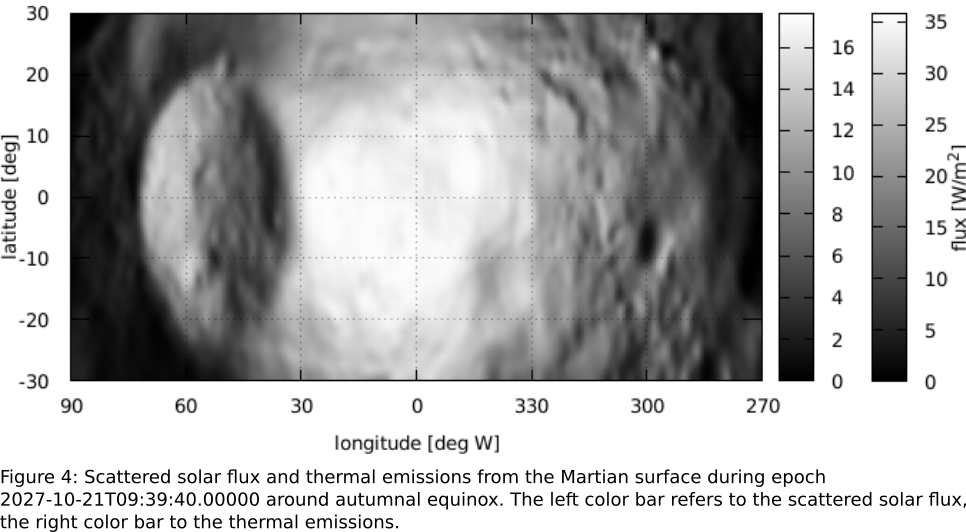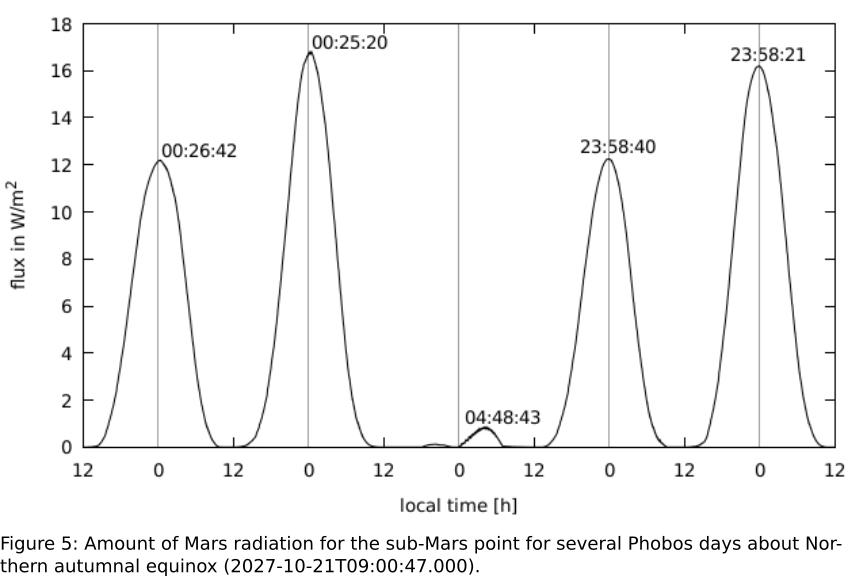Illumination conditions on Phobos for the MMX rover mission
- 1Technische Universität Berlin, Institute of Geodesy and Geoinformation Science, Berlin, Germany (ziese@tu-berlin.de)
- 2German Aerospace Center (DLR), Institute of Planetary Research, Berlin, Germany
Introduction
In preparation of the Phobos Rover experiment as part of JAXA’s Mars Moon eXplorer (MMX) mission, we study the illumination conditions on the Martian moon, focusing on the effects of eclipses and radiation from Mars.
JAXA's Mars Moon eXplorer (MMX) mission is due to launch in 2024 and is planned to arrive in the Martian system in 2025 [1]. The probe will deliver a rover [2], built by CNES and DLR, with contributions by INTA and JAXA, to the equatorial area of Phobos (latitude in [-30°, 30°]) between Dec. 15, 2026 and Aug. 15, 2027 [3]. A period of operations of 100 Earth days is planned, i.e. the nominal end of the rover’s mission is at latest on Nov. 23, 2027. Current plans [3] foresee a landing on the sub-Mars hemisphere (longitude in [0°W, 90°W] ∪ [270°W, 360°W]), which necessitates studies on the occurrence of eclipses and on contributions of radiation from Mars to the total incoming flux.
As [4] have shown, eclipses occur around spring and autumn equinox. At the sub-Mars point they can last for up to 55 minutes, which is a significant fraction of Phobos’ orbital period of only 7h 39 min. Thus, eclipses have a significant impact on the amount of energy available to the rover as it is powered by solar panels. Radiation from Mars comprises direct solar flux scattered by Mars towards Phobos and thermal emissions by the Martian surface. Both effects can be of advantage for the rover by providing additional solar energy and generating significantly higher surface temperatures [5] that may help the rover to survive the nights. On the other hand, Mars radiation can be hindrance for the evaluation of data gathered by the rover’s instruments.
Baseline Data
We used the shape model by [6], the rotation model from [7] and - as the rotation model is determined depending on it - the JPL ephemerides MAR097 for this study. To compute the radiation from Mars we use the Mars Climate Database, version 5.3 [8, 9].
Results
Given a location on Phobos, i.e. a facet of the shape model, an eclipse occurs if the facet is inclined to the Sun, and if the Sun is hidden behind Mars. The irregular shape of Phobos effects that even on this small body the eclipse duration is not the same for all locations on the sub-Mars hemisphere. Figure 1 shows the maximum eclipse duration for the currently envisioned landing area during the rover’s nominal mission time. The longest eclipses, lasting for 54.82 minutes, occur for a large area about the sub-Mars point. For some locations, e.g. at the Eastern part of crater Stickney or west of the crater rim, the maximum eclipse duration is much shorter.
Figure 2 shows the eclipse duration for the sub-Mars point and a location in the Eastern part of crater Stickney (lat -3.47°, lon -38.07°) during the rover’s nominal mission time. At autumnal equinox (occuring on Oct. 21, 2027), the eclipse durations attain their maxima of 54.82 minutes and 11.12 minutes, resp. If the rover is landed in an extended region about the sub-Mars point, then, due to solar power requirements of the rover, it is most beneficial to plan rover operations between 62 to 199 days past Dec. 15, 2026 to completely avoid eclipses. At the location at the Eastern part of Stickney the eclipse-free period is much longer and adds up to 205 days.

Since Phobos moves in a bound rotation, the fraction of the Martian disk that is visible from a given location of Phobos, is almost constant. The small changes of up to 7% caused by physical librations, orbital eccentricity and a slight out of equatorial plane movement, can, for this study, be neglected. Figure 3 shows the visibility of the Martian disk for autumnal equinox of Mars year 39.

Due to the bound rotation of Phobos, independent from the epoch, the largest amount of Mars radiation arrives close to the sub-Mars point, going further away from this region the amount of Mars radiation becomes smaller. Figures 4 shows the scattered solar flux and thermal emissions from the Martian surface close to autumnal equinox.

For longitudes near longitude 0° the amount of Mars radiation (scattered solar flux and thermal emissions) is maximum roughly around midnight. For these regions Mars radiation has a big influence on the temperature since then there is no direct solar flux. Going further away from longitude 0° the peaks of both kinds of Mars radiation shift towards the evening (lon in [0°W,90°W]) or morning [270°W, 0°W], resp. [5].
However, due to different lengths of Phobos' orbital period and Mars' rotational period, the positions and magnitudes of Mars radiation change somewhat from orbit to orbit, see Figure 5.

Acknowledgements:
This work was partly supported by research grant No. OB 124/14-1 from the Deutsche Forschungsgemeinschaft (DFG).
References:
[1] Kuramoto, K., et al.: Martian Moons eXploration (MMX): architecture of its science, EPSC-DPS Joint Meeting 2019, EPSC-DPS2019-1636-1, 2019.
[2] Murdoch, N., et al.: The Martians Moons eXploration (MMX) Rover to Phobos, EPSC 2020, EPSC2020-247, 2020.
[3] 4th MMX Science Working Team Meeting, February/March 2021.
[4] Li, Z.Q., et al.: Lighting condition analysis for Mars' Moon Phobos, 2016 IEEE Aerospace Conference, 2016.
[5] Kührt, E. & Giese, B.: A thermal model of the Martian satellites, Icarus, 81, 102-112, 1989.
[6] Willner, K. et al.: Phobos’ shape and topography models, PSS, 102, pp. 51-59, 2014.
[7] Archinal, B. A. et al.: Report of the IAU Working Group on Cartographic Coordinates and Rotational Elements: 2015. Celest. Mech. Dyn. Astron 130, 2018.
[8] Forget, F. et al.: Improved general circulation models of the Martian atmosphere from the surface to above 80 km. JGR 104, 24155–24176, 1999.
[9] Millour, E. et al.: The Mars Climate Database (version 5.3). From Mars Express to ExoMars, 2018.
How to cite: Ziese, R., Willner, K., and Oberst, J.: Illumination conditions on Phobos for the MMX rover mission, European Planetary Science Congress 2021, online, 13–24 Sep 2021, EPSC2021-427, https://doi.org/10.5194/epsc2021-427, 2021.

